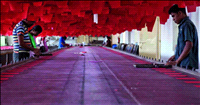Flu antibody’s ‘one-handed grab’ may boost effort toward universal vaccine, new therapies
29 Sep 2012
Scientists from The Scripps Research Institute and Sea Lane Biotechnologies have solved the co-crystal structure of a human antibody that can neutralise influenza viruses in a unique way.
The antibody recognises the crucial structure that flu viruses use to attach to host cells, even though previously this structure had been thought too small for an antibody to grab effectively. The immune protein manages to hit this precise spot by using just a small part of its target-grabbing apparatus. In so doing, it can neutralise a broad range of dangerous flu viruses.
''This highly focused binding to the receptor binding site using only a single loop on the antibody has never been seen before, and it's really fascinating; it gives us some good ideas about designs for vaccines and therapies,'' said Ian A. Wilson, the Hansen Professor of Structural Biology at Scripps Research. Wilson was senior investigator of the study along with Ramesh R. Bhatt of Sea Lane Biotechnologies. The report appears online ahead of print on September 16, 2012, in the journal Nature.
The power of large numbers
Sea Lane Biotechnologies, advised by Richard Lerner, the Lita Annenberg Hazen Professor of Immunochemistry at Scripps Research, began by collecting bone marrow from patients who had been exposed to certain key strains of flu. Because the bone marrow is a ''fossil record'' of all the antibodies a person has ever made, those at Sea Lane felt confident that the antibodies they were looking for would be there. Sea Lane's efforts even went as far as to include advertised appeals on Craigslist for individuals who had certain strains of the flu. Using the internationally and locally collected bone marrow, Sea Lane generated a ''comprehensive flu library'' of billions of antibodies.
Sea Lane Biotechnologies scientists, led by Bhatt, isolated the unusual new antibody, which they dubbed C05, by screening this enormous library for antibodies that could bind to proteins from a variety of influenza A viruses-the most dangerous family of flu viruses.
C05 also protected cells in the lab dish from infection by these viruses. In mice, relatively low doses of C05 prevented infections despite influenza A exposures that would have been lethal. The antibody worked as a therapy, too, rescuing 100 percent of mice when administered up to three days after a flu infection had begun.




























